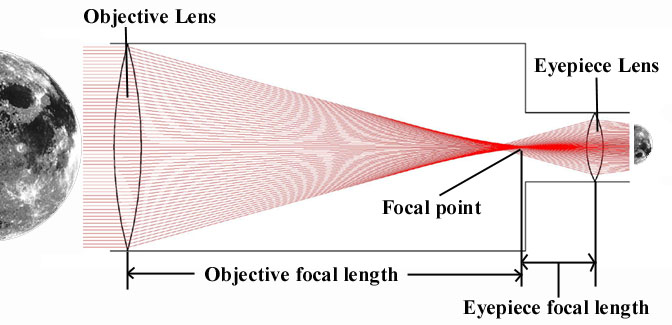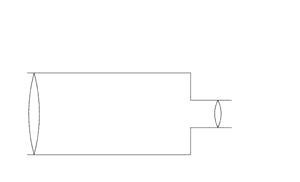
Refractor
How Refractor Telescopes Work
The principle behind the refractive telescopes is the use of two glass lenses (objective lens and eyepiece lens) to gather and bend parallel light rays in a certain way so that the image fits the size of the eye's pupil. Light rays is gather through the opening of the telescope called the aperture and passes through the objective lens and refracts onto a single point called the focal point. From there the light rays continue the same direction until it hits the eyepiece lens which also refract the light back into parallel rays. During the process, the image that enters our eyes is actually reverse of the original image and magnified because the size in which we preceive the image. The following diagram will show the components and the process of light rays traveling through a refractor telescope.

Magnification of a refractor telescope mainly depends on the distance of the eyepiece lens with regard to the focal point because the focal length determines how large the image get scale by. Typically a long focal length of the objective lens combine with a short focal length of the eyepiece lens will yield greater magnification. However, magnification is not the most important optical property for viewing astronomical phenomenon. The aperture size is more important because it accounts for the amount of light the telescope receives and the more light, the brighter the image. The size of aperture also accounts for the resolution power of the telescope. Larger aperture size will yield high quality of image, more crisp and detail image, and increase clarity of the image.
Advantages/Disadvantages
Advantages of a refractor telescopes
- After initial setup, refractor telescopes are less likely to be misalign than reflector telescopes.
- No cleaning is necessary inside the telescope because the tube is sealed off from contact with air.
- Temperature and air current cannot effect the refractor as much as a reflector because of the isolation from outside atmosphere.
Disadvantages of a refractor telescopes
- Refractor suffers from chromatic aberration due to the different index of refraction for different wavelengths.
- Quality of transmission of light through the lens depends on the wavelength.
- Quality of transmission of light decreases as the thickness of lens increase.
- Difficult to construct a perfect lens in terms of curvature and purity inside the lens.
- The objective lens will sag due to its own weight because the lens is only supported at the edge.
- The cost of a objective lens increases as the diameter of the lens increase, so cost efficiency verse quality of image, reflectors is better than refractors.
- The limitation of diameter size of the objective lens because the larger the lens, more problems such as chromatic aberration will occur.
Ray Tracing Through Refractor Telescope
The following is a sample trace of a ray through the refractor telescope lens system. Several assumption is made such as the radius of curvature for the lenses and index of refraction.

Page developed by Leo S.K. Cheng



